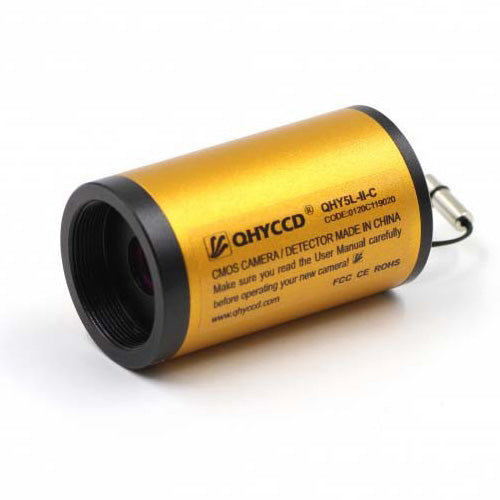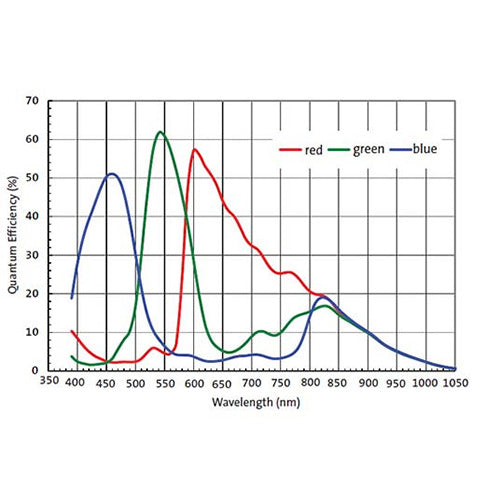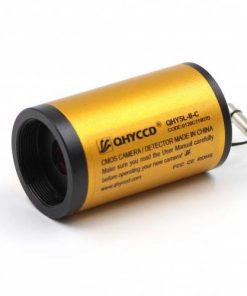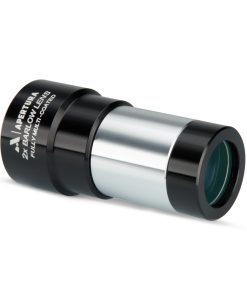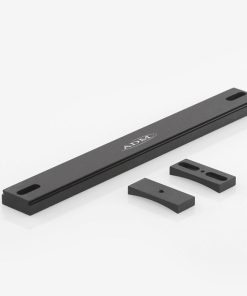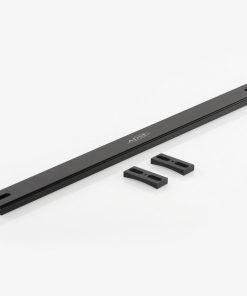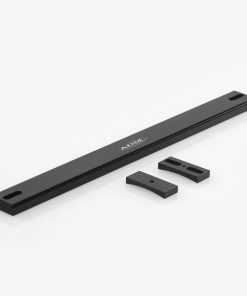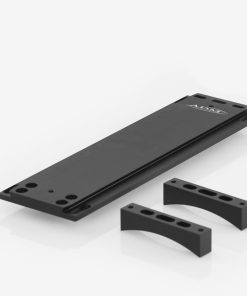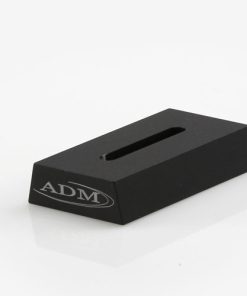QHYCCD 5L-II Color CMOS Planetary Camera & Autoguider – QHY5L-IIC QHY
$ 119,00 $ 47,60
QHY5-II Series Cameras
QHYCCD followed up the success of the QHY5 Guiding Camera by introducing its newest series of Planetary & Guiding Cameras, the QHY5-II. These cameras advance the data transfer speed all the way to the maximum USB 2.0 data rate of 39 MB per second, 30 FPS @ 1280×1024, or 1280×960 on current computer systems, and hundreds of frames per second in particular ROI modes.
QHY5-II cameras fit in a common 1.25″ eyepiece adapter and feature an adjustable location ring for confocal imaging with an eyepiece. Optimal for use as a light weight auto guider. The QHY5-II comes in a compact yet robust package. It has an improved thermal design that enables the heat produced by the CMOS sensor to be moved externally to the telescope’s eyepiece tube.
This QHY5-II camera is equipped with both Native WDM and Broadcast WDM drivers. This means you can also utilize this camera as a superior, high-performance webcam for capturing video or presenting a live video broadcast to show off your astronomy images to your friends in real time!
QHY5L-II Color CMOS Camera & Autoguider
As with all QHY5-II cameras, the QHY5L-II sports high sensitivity and low noise. Many have found the image quality of the QHY5L-II to equal or even surpass that of cameras with a ICX618 sensor. Readout noise is incredibly low – as few as four electrons. The QHY5L-II contains a Aptina MT9M034 sensor with on-chip FPN (Fixed Pattern Noise) calibration capability, fixing one of the primary drawbacks of CMOS technology for images that are clear and consistent, even under high gain. With these assets, the QHY5L-II offers excellent image quality for imaging planets, deep-sky objects or for autoguiding. Also available in monochrome.
Planetary Imaging
With a frame rate range of between 30 and 200 frames, the QHY5L-II camera is an instrument best suited for capturing planetary images. Although high frame rates help reduce the amount of atmospheric agitation that influences the image, they also result in short exposure times.
Lunar Imaging
The QHY5L-II also makes achieving high resolution lunar images a simple task. Image stacking will result in highly detailed images of the lunar surface.
Deep Sky Imaging
Even though the QHY5L-II is not a cooled camera, it still has the capacity to take bright images of deep sky objects. This is especially true of small galaxies and planetary nebulae. Ordinarily, this can be done via short exposures and large quantity stacking. You may have to enable EZPlanetary’s auto-dark frame subtract function to get concurrent dark frame calibration to eliminate the thermal noise on images with long exposure times. Please note you will need to reload the auto-dark frame calibration if you have altered the gain or exposure time.
AutoGuiding
The QHY5L-II is an acclaimed autoguiding camera. In 2015, QHY came out with a miniGuideScope made specifically for QHY5L-II cameras. This can be found in the accessories section at the bottom left of this page. The QHY5L-II is compact and lightweight, making it the perfect camera component of an ultra portable guide system. The monochrome version has a 74% high QE and you can locate the guide star anywhere.
Image depicts an orange version of the QHY5L-II Color CMOS Camera & Autoguider, which comes standard in silver.
Quick Shipping and Professional Packaging
Due to our longstanding partnership with UPS FedEx DHL as well as other major international carriers, we are able to provide various shipping options. Our warehouse personnel are well trained and will be able to pack your goods in accordance with the exact and precise specifications. Your goods are thoroughly checked and securely secured prior to shipment. Everyday we deliver hundreds of packages to our customers from all over the world. Our determination to be the biggest online retailer in the world is shown by this. The warehouses are located situated in Europe in the same way as they are in the USA.
Note: Orders containing multiple items will have a separate processing period for each item.
We will carefully examine all products before they are shipped. Today, the majority of orders will be delivered within 48 hours. The delivery time will be between 3-7 working days.
Returns
We don't manage the stock at our warehouse and factory. The actual inventory may fluctuate at any time. It's possible that you may not receive your order once it's been placed.
Our policy is for 30 days. We are unable to return or exchange your purchase after 30 days since the purchase.
In order for your item to be eligible for return the item must not be opened and in the condition you received it. It must also remain in the original packaging.
Related products
Telescope Accessories
Telescope Accessories
ADM Accessories Celestron CGX Side-By-Side Adapter – CGX-SBS ADM
Telescope Accessories
Telescope Accessories
Apertura 10mm 70º Super Wide Angle Eyepiece – 1.25″ – SWA10 Apertura
Telescope Accessories
ADM Accessories CGEM Counterweight Bar 22 Inches – CGEM-CW ADM
Telescope Accessories
ADM Accessories CGEM Knob Upgrade – Two Orange Anodized Spreader Bar Knobs – CGEM-SB-OR ADM
Telescope Accessories
ADM Accessories Mini Dovetail Bars for Mounting – MDS-M8 ADM
Telescope Accessories
Apertura 1.25″ Chrome Barrel for 1.25″ Eyepieces, Barlows & Diagonals – 125B Apertura
Telescope Accessories
ADM Accessories Tripod Knob Set for Losmandy G11 & Celestron CI700 Mounts – Clear – TKS-CL ADM
Telescope Accessories
Telescope Accessories
ADM Accessories Tripod Knob Set for Losmandy G11 & Celestron CI700 Mounts – Orange – TKS-OR ADM
Telescope Accessories
Telescope Accessories
ADM Mini Dovetail Bar for Celestron 9.25″ SCT – MDS-C925 ADM
Telescope Accessories
ADM Accessories D Series Dovetail Plate for Celestron 9.25″ SCT OTA – DC925 ADM
Telescope Accessories
ADM V Series Universal Dovetail with 100 mm Rings – VDUPR-100 ADM
Telescope Accessories
ADM Accessories Vixen Style Dovetail for Meade 8″ SCT – VM8 ADM
Telescope Accessories
ADM V Series Dovetail Plate for Celestron 9.25″ SCT – Orange – VC925-O ADM
Telescope Accessories
Telescope Accessories
ADM V Series Dovetail Bar for Celestron 8″ SCT – Extra Long – VC8-XL ADM
Telescope Accessories
Apertura 1.25″ Neutral Density Filter 13% Transmission – ND96-0.9 – A-ND91 Apertura
Telescope Accessories
ADM Accessories Tripod Knob Set for Losmandy G11 & Celestron CI700 Mounts – Black – TKS-BK ADM
Telescope Accessories
ADM Accessories Vixen Style Universal Dovetail Telescope Mounting Bar – 14″ Long – VDUP14 ADM
Telescope Accessories
ADM V Series Dovetail Bar for Celestron 8″ SCT – Orange Anodized – VC8-O ADM
Telescope Accessories
ADM Tripod Knob Set for Celestron CGE Pro Mount – CGE-PRO-TKS ADM
Telescope Accessories
ADM Accessories Vixen Style Universal Dovetail Telescope Mounting Bar – 7″ Long – VDUP7 ADM
Telescope Accessories
ADM Accessories Rosette Tripod Knobs for Celestron Advanced VX Mount – VX-TKS ADM
Telescope Accessories
ADM Replacement Azimuth Knobs for Celestron Advanced VX Mount – VX-AZ ADM
Telescope Accessories
ADM Accessories Tripod Knob Set for Losmandy G11 & Celestron CI700 Mounts – Blue – TKS-BL ADM
Telescope Accessories
ADM Accessories Vixen Style Universal Dovetail Telescope Mounting Bar – 3″ Long – VDUP3 ADM
Telescope Accessories
ADM Accessories Vixen Style Dovetail for Celestron C8 – VC8 ADM
Telescope Accessories
ADM Accessories Vixen Style Dovetail for Celestron 9.25″ SCT – VC925 ADM
Telescope Accessories
ADM Accessories CGEM Knob Upgrade – Altitude Locking Knob – CGEM-T-OR ADM
